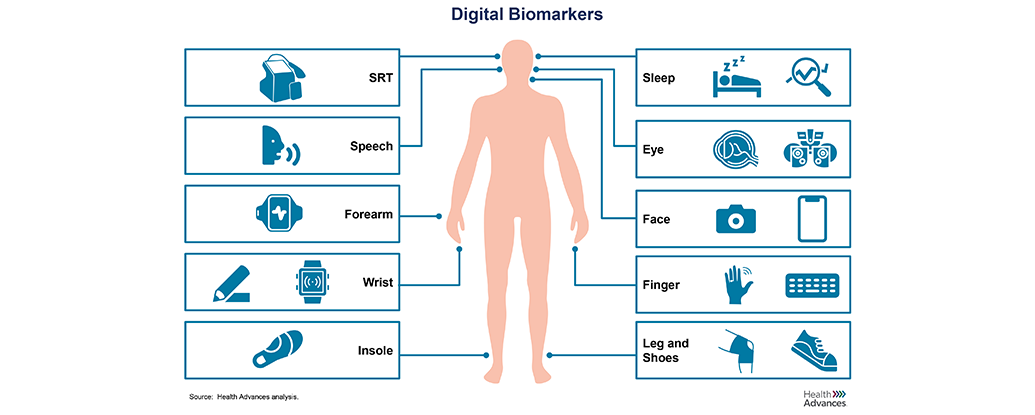
Blog | 12/18/2024
Revolutionizing Neuroscience: The Rise of Digital Measures, Assessments and Biomarkers
By Jeff Abraham, Partner, Mike Davitian, Partner, and Martha O’Neill, Vice President
Digital and hybrid assessment, biomarkers, and measures collect objective physiological and behavioral data via mobile methods and devices, including wearables, sensors, and smartphones. Collecting data about how a patient walks, talks, sees, and feels in daily life—by measuring their gait, balance, activity, sleep, speech patterns, vision, smell, and mood—could allow neuroscience sponsors to augment (or replace) subjective rating scales or intermittent measures with more objective and continuous data. Digital and hybrid biomarkers have the potential to capture changes in disease progression earlier and more precisely using unobtrusive at-home monitoring that is less burdensome for patients. In so doing, they can lower the cost of trials through fewer site visits and empower sponsors to make faster adaptive trial decisions.
To identify and accelerate neuroscience treatments that deliver value to patients, DBx must advance “from ambition to impact.” Just a handful of DBx have been validated; most are immature. Sponsors are understandably cautious about collecting novel digital data; they must manage regulatory risks, development costs, and product timelines while achieving a reasonable return on investment (ROI). That requires a strategic plan for developing, evaluating, and integrating DBx into clinical trials, considering post-approval commercial opportunities, and anticipating how the DBx validation process may evolve. At Parexel and Health Advances, we have advised large pharmaceutical and emerging biopharma companies on realizing DBx's potential while mitigating the risks and controlling costs. Here are three strategies that work:
- Leverage digital assessment, biomarkers, and measures where they add the most value: Many sponsors assume that their investment in DBx will accelerate clinical development and that digital biomarkers used in clinical trials can be deployed commercially to accelerate adoption. That is not always the case. Some DBx will add most value during development—to make clinical trials more efficient and inform faster go-no-go product decisions—but they aren’t practical solutions that can be deployed in the real world to support commercialization. To understand whether a DBx could add value in a commercial context, sponsors must examine a technology’s current level of validation, the quality of evidence generated, product-market fit, the likelihood of real-world adoption and reimbursement, business model feasibility, and go-to-market strategy.
- Select technology partners that fit your development strategy: The market landscape for digital biomarkers is evolving rapidly, so companies seeking to invest or find a partner have many choices of innovative technologies and business models. In making their choices, sponsors should consider the level of innovation, validation, scalability, technical capability and potential, and user-friendliness of digital technology. Emerging companies with limited budgets should not assume that DBx will replace traditional subjective scales and assessments, most of which will continue to be required for at least the next five years.
- Understand commercial deployment realities: Successful commercial application of digital biomarkers is challenging and requires meaningful evidence for payer coverage and reimbursement, physician uptake, and patient engagement. Deploying digital biomarkers to generate evidence is more complex than adding smartwatches to a clinical trial. It requires operational expertise, specialized patient and site training, sustained tech support and troubleshooting, and sophisticated data analytics. Companies that identify a DBx capable of detecting disease progression, medication side effects, or adverse medication events earlier or more accurately can brand that tool and own the possibility of delivering effective treatment to more patients.
The successful integration of digital biomarkers (DBx) into clinical development and commercialization requires a strategic approach that balances innovation with practical realities. By anticipating and navigating hurdles thoughtfully, companies can harness the potential of digital biomarkers to enhance patient outcomes and drive meaningful advancements in healthcare.
Curious to learn more? Read the full article here.
Authors
- Jeffrey Abraham, Partner, Co-leads Health Advances’ Health IT and Digital Health practice
- Mike Davitian, Partner, Leader in Health Advances’ Biopharma practice
- Martha O'Neill, Vice President, Leader in Health Advances’ Digital Health and Diagnostics practices

